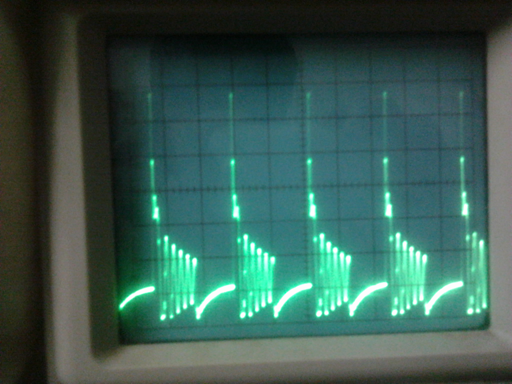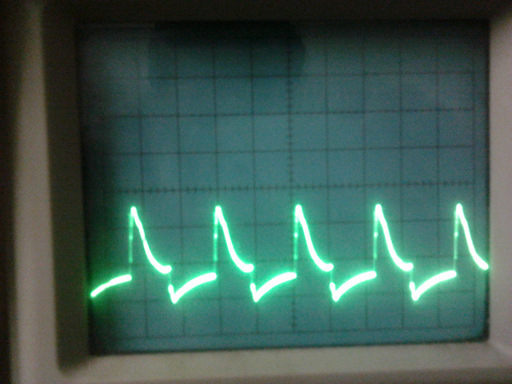Taswar
Junior Member level 1

Hi all,
I'm trying to make an offline flyback converter. Since I can't get readily wound transformers, I need to wind my one. I got a few EE25 cores and bobbins and am aiming to make a 14V 2A flyback converter. I've been reading a lot on flyback and I think I got the idea. Last few times I tried (about a few months back), there was output for a few seconds and then BANG!!!
So I've been reading on flyback. I carried out calculations and stuff and arrived at this:
Primary: 147 turns
Secondary: 9 turns
Bias: 10 turns
I used thick paper and glue to get a gap of about 1mm (measured with slide caliper) between all three legs.
Before anything blew up again, I set up a circuit with UC3845 running at around 90kHz at 48% (max) duty cycle and pulsed an IRF3205 off a 12v line. The IRF3205 drove the secondary of the transformer and I set up a diode, cap and a load resistor on the bias just to check the drain waveform. The IRF3205 got EXTREMELY HOT and burnt. So, I placed an IRF840, which also gets EXTREMELY HOT, but didn't burn out.
This is the drain waveform with no snubber:


This is the drain waveform with an RCD snubber (diode - BYV26E, cap - 4.7u 100v, res - 4.7R 2W):

I'm doubting one of two things here:
1) It is due to poor winding or any such thing relevant which caused excessive leakage inductance.
2) My snubber values are completely wrong.
Can someone help identify the problem? Are the transformer calculations and airgap right?
I think if I make my offline PSU, the MOSFET will go kaboom! So, what can I do?
By the way, I didn't measure the secondary and bias windings, but the primary winding (147 turns) was about 1.47mH. Without the air gap, it was about 16mH.
Thanks in advance.
I'm trying to make an offline flyback converter. Since I can't get readily wound transformers, I need to wind my one. I got a few EE25 cores and bobbins and am aiming to make a 14V 2A flyback converter. I've been reading a lot on flyback and I think I got the idea. Last few times I tried (about a few months back), there was output for a few seconds and then BANG!!!
So I've been reading on flyback. I carried out calculations and stuff and arrived at this:
Primary: 147 turns
Secondary: 9 turns
Bias: 10 turns
I used thick paper and glue to get a gap of about 1mm (measured with slide caliper) between all three legs.
Before anything blew up again, I set up a circuit with UC3845 running at around 90kHz at 48% (max) duty cycle and pulsed an IRF3205 off a 12v line. The IRF3205 drove the secondary of the transformer and I set up a diode, cap and a load resistor on the bias just to check the drain waveform. The IRF3205 got EXTREMELY HOT and burnt. So, I placed an IRF840, which also gets EXTREMELY HOT, but didn't burn out.
This is the drain waveform with no snubber:


This is the drain waveform with an RCD snubber (diode - BYV26E, cap - 4.7u 100v, res - 4.7R 2W):

I'm doubting one of two things here:
1) It is due to poor winding or any such thing relevant which caused excessive leakage inductance.
2) My snubber values are completely wrong.
Can someone help identify the problem? Are the transformer calculations and airgap right?
I think if I make my offline PSU, the MOSFET will go kaboom! So, what can I do?
By the way, I didn't measure the secondary and bias windings, but the primary winding (147 turns) was about 1.47mH. Without the air gap, it was about 16mH.
Thanks in advance.
Last edited:

